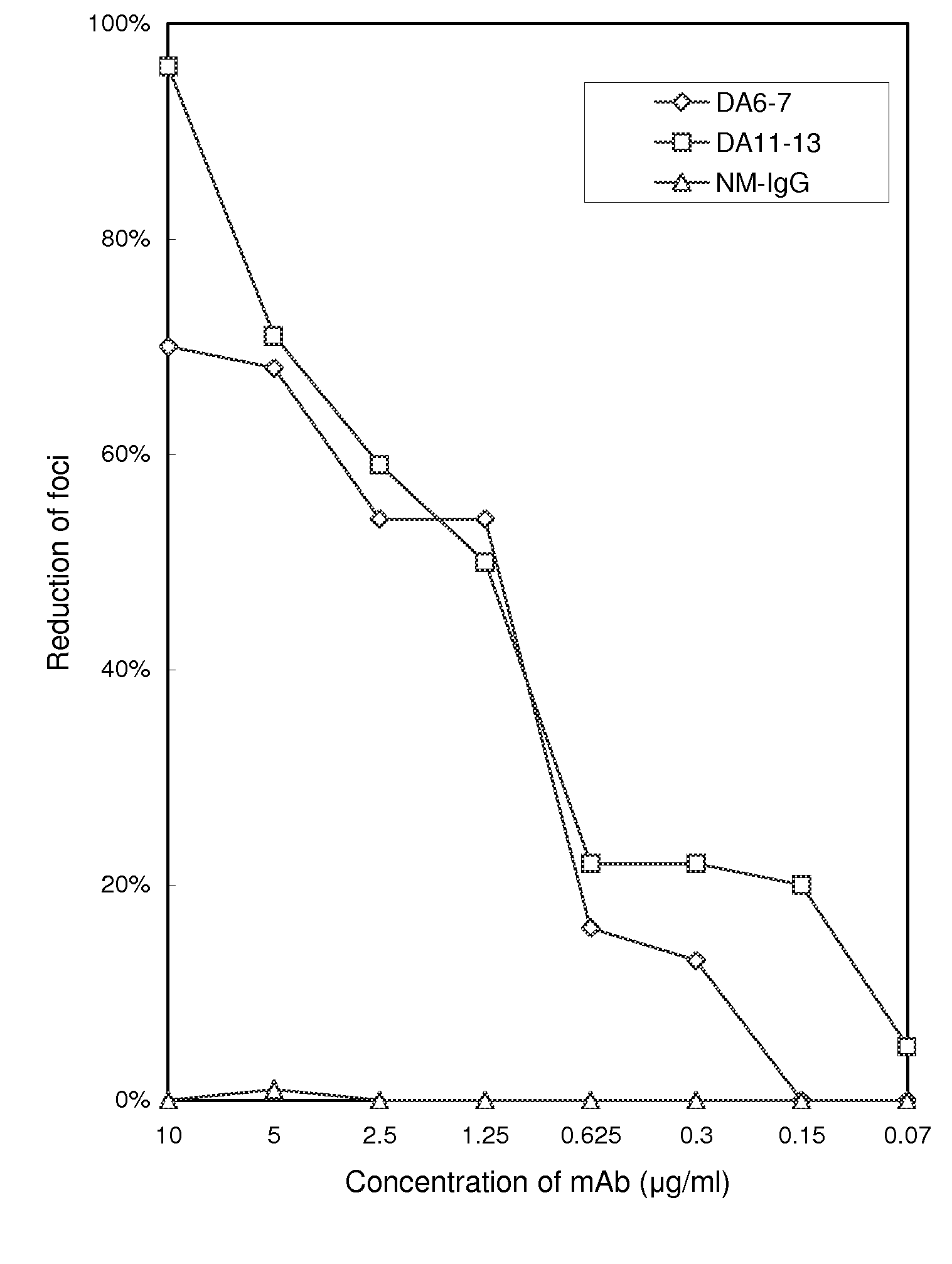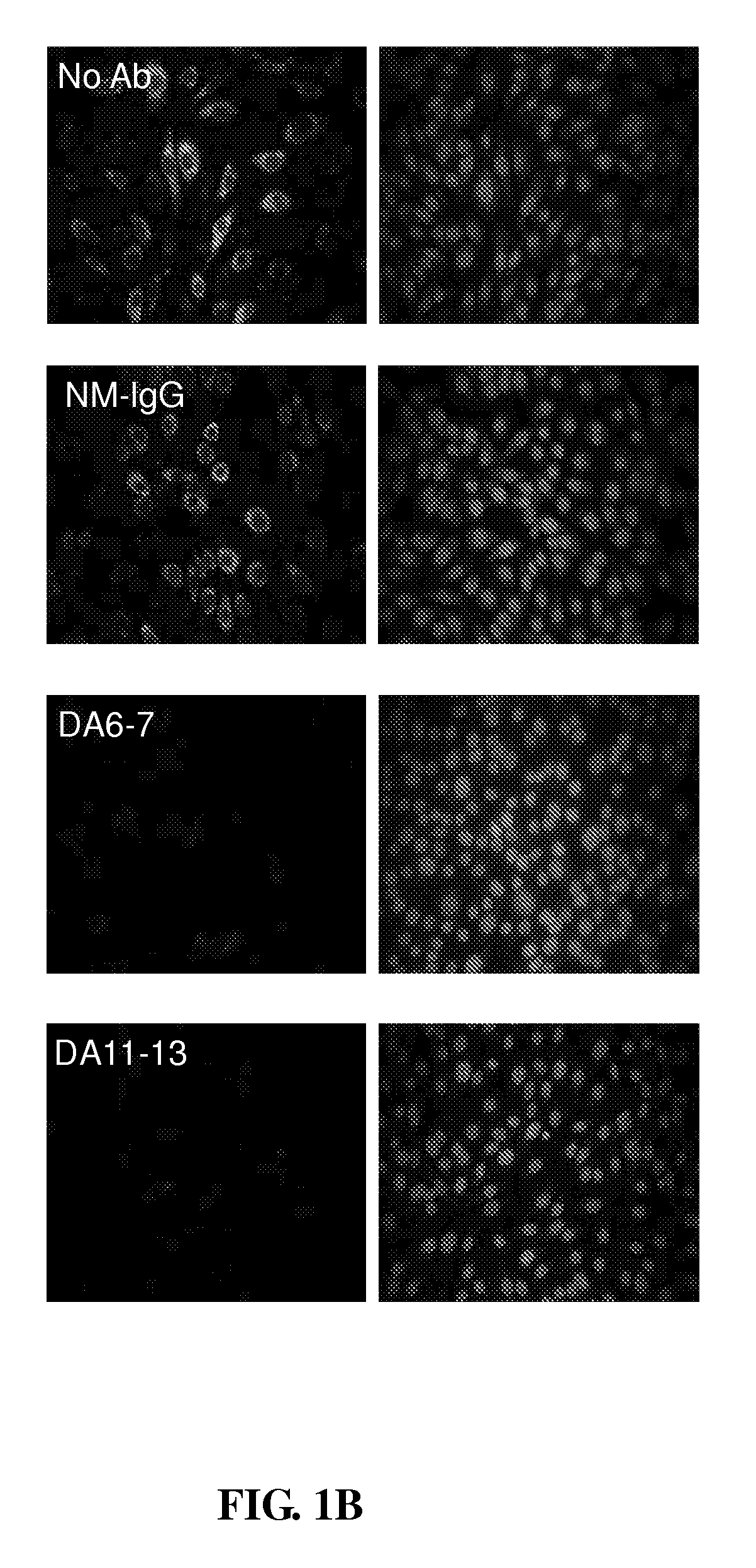Antigen of Dengue Virus Type 1
- Summary
- Abstract
- Description
- Claims
- Application Information
AI Technical Summary
Benefits of technology
Problems solved by technology
Method used
Image
Examples
example 1
[0025]Generation and Characterization of mAbs Against DEN-1
[0026]To screen the epitopes of DEN-1, mAbs against thereof were needed to generate first. According to the present invention, DEN strain used was a local Taiwan strain, DEN-1 766733, isolated from patients with DF. Four prototype dengue viruses, e.g. DEN-1 (Hawaii), DEN-2 (New Guinea C), DEN-3 (H87) and DEN-4 (1241), were also provided. All viral strains were used to infect mosquito C6 / 36 cells with growth medium containing 50% Mitsumashi and Maramorsch Insect Medium (MMIM; Sigma) plus 50% Dulbecco's modified Eagle's minimal essential medium (DMEM; GIBCO). The DEN-infected C6 / 36 cells were incubated at 28° C. for 7 to 9 days, and the viruses were harvested from the supernatants by known methods.
[0027]Hybridoma cells secreting anti-DEN-1 antibodies were generated according to standard procedure (Kohler, G & Milstein, C. (1975). Continuous cultures of fused cells secreting antibody of predefined specificity. Nature 256, 495-7...
example 2
[0037]Screening immuopositive phage clones with neutralizing antibodies against DEN-1
[0038]To identify the B-cell epitopes of DEN-1 specifically recognized by DA6-7 and DA11-13, a phage-displayed random peptide library (New England BioLabs, Inc. Beverly, Mass.) was employed. Through a selection process called biopanning, the phage clones recognized by mAbs DA6-7 and DA11-13 were selected, and the peptide displayed thereby would then be identified.
[0039]Before the biopanning step, the ELISA plate was first coated with 100 μg / ml of neutralizing mAbs DA6-7 and DA11-13 respectively in 0.1M sodium bicarbonate buffer (pH 8.6). The plate was incubated with blocking buffer (1% bovine serum albumin in PBS) at 4° C. overnight and then washed with PBST0.5 (PBS+0.5% [w / v] Tween-20). The phage displayed 12-mer peptide library was used in the present example, and the phage display biopanning procedures were performed according to known method (Wu, H. C., M. Y. Jung, C. Y. Chiu, T. T. Chao, S. C. ...
example 3
[0042]DNA Sequencing and Sequence Analysis
[0043]Immunopositive phage clones were further characterized by DNA sequencing. The phage clones selected from Example 2 were amplified and precipitated with one-sixth volume of polyethylene glycol-NaCl solution (20% (w / v) PEG-8000 and 2.5M NaCl). The precipitated phage pellets were resuspended in 100 μl of iodine buffer (10 mM Tris-HCl, pH 8.0; 1 mM EDTA; 4 M NaI) at room temperature for 10 min after adding 250 μl of ethanol. Phage DNA was isolated from the pellet after centrifugation at 12,000×g for 10 min, washed with 70% ethanol, dried, and resuspended in 50 μl of distilled water. DNA sequences of purified phages were determined according to the dideoxynucleotide chain termination method by automated DNA sequencer (ABI PRISM 377, Perkin-Elmer, Calif., USA). The phage-displayed peptide sequences were translated and aligned with the Genetics Computer Group (GCG) program, and the results were shown in Table 2.
TABLE 2Alignment of phage-displ...
PUM
 Login to View More
Login to View More Abstract
Description
Claims
Application Information
 Login to View More
Login to View More - R&D
- Intellectual Property
- Life Sciences
- Materials
- Tech Scout
- Unparalleled Data Quality
- Higher Quality Content
- 60% Fewer Hallucinations
Browse by: Latest US Patents, China's latest patents, Technical Efficacy Thesaurus, Application Domain, Technology Topic, Popular Technical Reports.
© 2025 PatSnap. All rights reserved.Legal|Privacy policy|Modern Slavery Act Transparency Statement|Sitemap|About US| Contact US: help@patsnap.com



